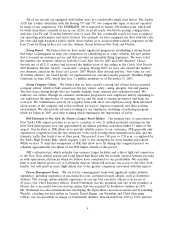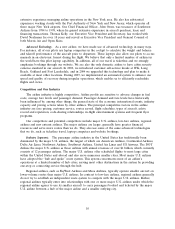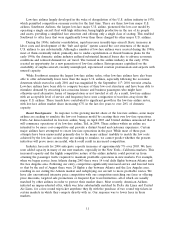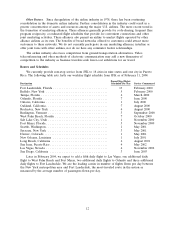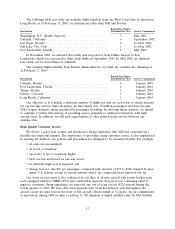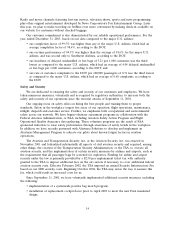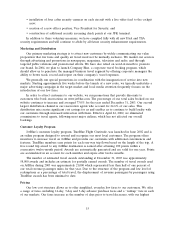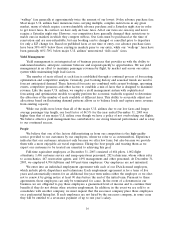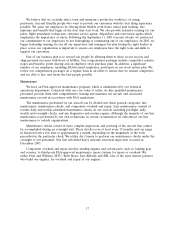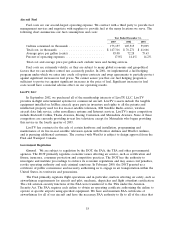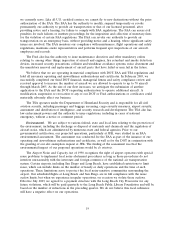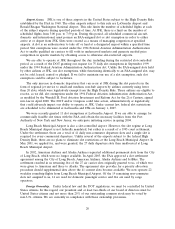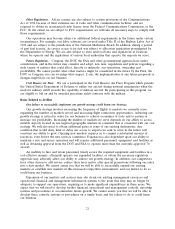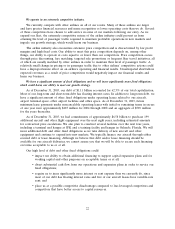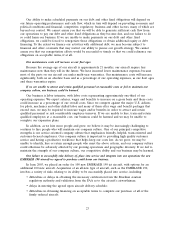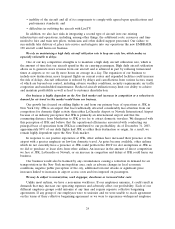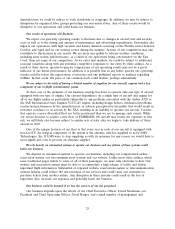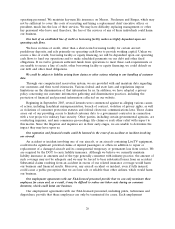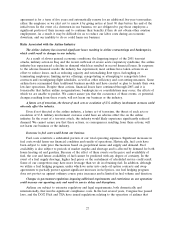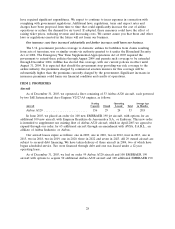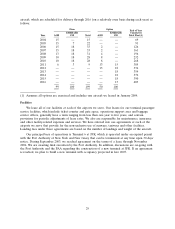JetBlue Airlines 2003 Annual Report Download - page 22
Download and view the complete annual report
Please find page 22 of the 2003 JetBlue Airlines annual report below. You can navigate through the pages in the report by either clicking on the pages listed below, or by using the keyword search tool below to find specific information within the annual report.we currently serve. Like all U.S. certified carriers, we cannot fly to new destinations without the prior
authorization of the FAA. The FAA has the authority to modify, suspend temporarily or revoke
permanently our authority to provide air transportation or that of our licensed personnel, after
providing notice and a hearing, for failure to comply with FAA regulations. The FAA can assess civil
penalties for such failures or institute proceedings for the imposition and collection of monetary fines
for the violation of certain FAA regulations. The FAA can revoke our authority to provide air
transportation on an emergency basis, without providing notice and a hearing, where significant safety
issues are involved. The FAA monitors our compliance with maintenance, flight operations and safety
regulations, maintains onsite representatives and performs frequent spot inspections of our aircraft,
employees and records.
The FAA also has the authority to issue maintenance directives and other mandatory orders
relating to, among other things, inspection of aircraft and engines, fire retardant and smoke detection
devices, increased security precautions, collision and windshear avoidance systems, noise abatement and
the mandatory removal and replacement of aircraft parts that have failed or may fail in the future.
We believe that we are operating in material compliance with DOT, FAA and TSA regulations and
hold all necessary operating and airworthiness authorizations and certificates. In February 2003, we
successfully completed our third DOT financial, managerial fitness and safety compliance review and
received approval to increase the number of aircraft we are allowed to operate to up to 70 aircraft
through March 2005. As the size of our fleet increases, we anticipate the submission of another
application to the FAA and the DOT requesting authorization to operate additional aircraft. A
modification, suspension or revocation of any of our DOT or FAA authorizations or certificates could
materially adversely affect our business.
The TSA operates under the Department of Homeland Security and is responsible for all civil
aviation security, including passenger and baggage screening, cargo security measures, airport security,
assessment and distribution of intelligence, and security research and development. The TSA also has
law enforcement powers and the authority to issue regulations, including in cases of national
emergency, without a notice or comment period.
Environmental. We are subject to various federal, state and local laws relating to the protection of
the environment, including the discharge or disposal of materials and chemicals and the regulation of
aircraft noise, which are administered by numerous state and federal agencies. Prior to our
governmental certification, our projected operations, particularly at JFK, were studied in an FAA
environmental assessment. The assessment was conducted for the FAA as part of the issuance of our
operating and airworthiness authorizations and certificates, as well as for the DOT in conjunction with
the granting of our slot exemption request at JFK. The finding of the assessment was that the
environmental impact of our proposed operations would be de minimis.
The Airport Noise and Capacity Act of 1990 recognizes the right of airport operators with special
noise problems to implement local noise abatement procedures as long as those procedures do not
interfere unreasonably with the interstate and foreign commerce of the national air transportation
system. Certain airports, including San Diego and Long Beach, have established restrictions to limit
noise, which can include limits on the number of hourly or daily operations and the time of such
operations. These limitations serve to protect the local noise-sensitive communities surrounding the
airport. Our scheduled flights at Long Beach and San Diego are in full compliance with the noise
curfew limits, but when we experience irregular operations, on occasion we violate these curfews.
Effective July 2003, we agreed to a payment structure with the Long Beach City Prosecutor for any
future violations, which will be paid quarterly to the Long Beach Public Library Foundation and will be
based on the number of infractions in the preceding quarter. We do not believe this local ordinance
will have a negative effect on our operations.
19


